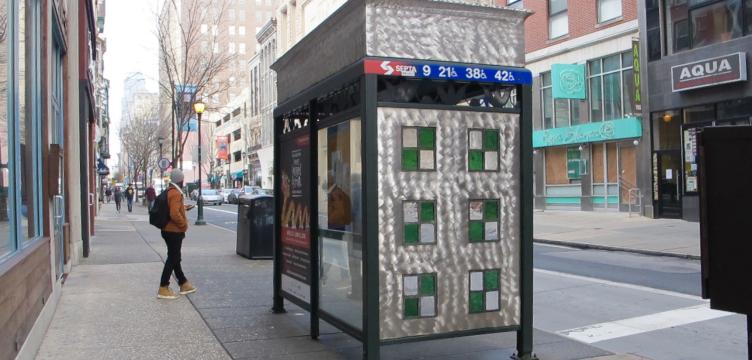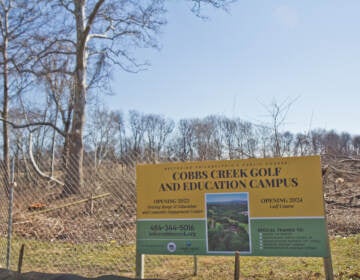Art is compromising: Commission OKs city’s plan to replace, but reuse, Chestnut Street’s stained-glass bus shelters

At the beginning of the year, the City of Philadelphia attempted to replace Chestnut Street’s bus shelters with new ones, which would have meant the deaccessioning of stained-glass art installations that currently beautify eleven of the street’s transit stops.
But the Art Commission, and the public, wasn’t having it. Even the artist, Pablo Tauler, didn’t care for the proposed removal of the art he created for the city back in 1999.
The backlash at the commission’s January meeting got so fierce that the city withdrew their deaccessioning proposal and promised to find another path forward.
At September’s Art Commission meeting on Wednesday, the city unveiled its alternative proposal.
The stained-glass artwork will still be removed — the bus shelters it beautifies are too far gone to repair — but it will be put in storage with the intent to make use of Tauler’s work again.
After an hour of debate, the commissioners signed off on the artwork’s removal and storage and the staggered installation of the new shelters as the old ones become too rusted for use. They also asked the city to take a serious look at their ability to incorporate Tauler’s artwork into the new shelters and to come up with a schedule for reusing whichever pieces can’t be placed there.
After the meeting Patricia Ellis Dinatale, transit program manager for the city’s Office of Transportation and Infrastructure systems, told PlanPhilly that even if the art can be placed in the shelters, there is no guarantee the artwork would be reinstalled in exactly the same places. But she said the Chestnut Street option would be given priority. She emphasized that the city is no longer asking to deaccession the artwork.
Commissioners impressed upon the city that a rigorous schedule would need to be kept when it came to reusing the Tauler’s work.
“I’m concerned this could go into a storage blackhole,” said Natalie Nixon, a commissioner and professor at Philadelphia University. “As part of moving this forward, I would like you to commit to a really specific timeline and written out plan so that five years later these aren’t just abandoned relics.”
In its presentation, the city stated that they removed the bus shelter and art installation at 12th and Chestnut Streets in August for the purpose of studying its condition.
They found that the shelter’s base beam suffered from serious corrosion. The leg supports were badly rusting. In one case, a leg was so badly deteriorated, and riddled with holes, that water and detritus accumulated inside it. When workers sawed the leg off, gallons of rusty water came pouring out.
Given the sorry state of the shelters, and the fact that they are so outdated that replacement parts are impossible to acquire, Commission Chairman Alan Greenberger reminded his colleagues that the art would need to be moved no matter what.
“That’s out of our hands,” said Greenberger. “The question before the commission is what happens afterwards.”
The Art Commission members still appeared frustrated at the idea that funds are lacking for the repair, or rapid reinstallation of the stained glass panels in a roughly similar formation their currently placement. The shelters are being replaced as part of a plan that will eventually double the overall number, paid for thanks to new digital advertisements on the sides of the new shelters. The ads are expected to generate at least $100 million for the city’s general fund over the next 20 years.
Greenberger concluded the meeting by asking the city to produce a report on whether the artwork can be incorporated into the new shelters quickly — preferably in the next month or two. As a result, the Art Commission will likely be hearing more about the future of Tauler’s work later this fall.
WHYY is your source for fact-based, in-depth journalism and information. As a nonprofit organization, we rely on financial support from readers like you. Please give today.





